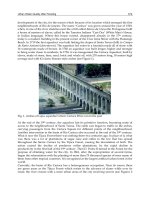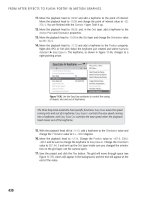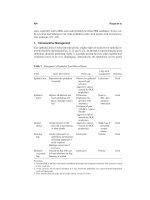Positioning Techniques in Surgical Applications - part 10 pps
Bạn đang xem bản rút gọn của tài liệu. Xem và tải ngay bản đầy đủ của tài liệu tại đây (1.13 MB, 31 trang )
Chapter 21 · Paediatric surgery284
21
21.1.3
Lateral position
. Figs. 21.11–21.16.
Indications
Congenital deformities to the oesophagus (e.g. oesophagus atresia, oesopha-
gus duplications), open and minimally invasive procedures to the lungs (e.g.
sequestra, bronchiectasis, tumours).
Lateral position on the healthy side, position on the left-hand side for
oesophagus atresia
Preparations
4 Gel cushions/sandbags, possibly wedge cushion
4 Gel cushions for the legs
4 Leg holders (only for larger children)
4 Padding for the legs and feet
4 Warming mat, warming lamp
Positioning
4 Children’s operating table in the neutral position
4 Connect the warming mat and lamp, affix the temperature sensor
4 Prepare and induce the anaesthetic in the supine position
4 Transfer to the lateral position in the operating theatre
4 The upper arm is positioned in the cranial direction, padded and fixed in
a cloth sling to the anaesthetic screen, for infants the arm is fixed in a lying
position at the head with plaster strips
4 In larger children, pull the lower arm so that the body weight does not lie
directly on the shoulder and extend in this position
4
Stabilise the body with sandbags or gel cushions, possibly wedge cushions
4 Fix the lower leg with body belts for older children and plaster strips for
younger children
4 Pad the parts of the body at risk from pressure
4 Apply the neutral electrode, connect to the HF surgery device
4 Use compresses to protect the electrode during disinfection
4 Position the operating lamps
Risks
4 Positioning injuries from lacking or inadequate padding (particularly for
the face and genitals)
4 Burns from lacking moisture protection for the neutral electrode
21.1 · Various positions
21
285
. Fig. 21.16. Lateral position for lower lobe resection
. Fig. 21.15. Arm positioning
. Fig. 21.14. Padding under the legs. Fig. 21.13. Padding under the back
. Fig. 21.11. Modified lateral position for thoracoscopy . Fig. 21.12. Arm spread out, fixed to the anaesthesia screen
Chapter 21 · Paediatric surgery286
21
21.1.4
Lithotomy position
. Figs. 21.17–21.21.
Indications
Rectoscopy, cystoscopy and procedures to the anus and rectum (e.g. abscesses,
perianal vein thrombosis).
Preparations
4 Two leg holders, pads for the legs
4 Warming mat, warming lamp
4 Arm position device only for older children
Positioning
4 Children’s operating table in the neutral position
4 Connect the warming mat and lamp, affix the temperature sensor
4 Prepare and induce the anaesthetic in the supine position
4 Spread out and pad the arms of older children
4 Fit the leg holders to the corresponding clamps
4 Position the legs and remove the leg plates
4 For infants, the legs can be hung in slings or from the anaesthesia screen
4 Position the pelvic just above the edge of the buttocks plate
4 Lower the still raised legs until the thighs are almost horizontal
4 Pad the parts of the body at risk from pressure
4 Position the operating lamps
Risks
4 Positioning injuries from lacking or inadequate padding (particularly for
the face and genitals)
4 Burns from lacking moisture protection for the neutral electrode
21.1 · Various positions
21
287
. Fig. 21.17. Cystoscopy, padded leg holders
. Fig. 21.21. Padding of the legs
. Fig. 21.20. Lateral view of the positioning. Fig. 21.19. Lateral view of the positioning
. Fig. 21.18. Spreading the legs out at right angles
22
22 Special aspects of Iso-C3D
and navigation applications
22.1 Iso-C3D applications with and without navigation – 290
22.1.1 Vertebral column – 290
22.1.2 Pelvis/acetabulum – 294
22.1.3 Elbow/wrist – 296
22.1.4 Hips/DHS/neck of the femur: screwed solutions – 298
22.1.5 Head of the tibia and lower leg – 300
22.1.6 Ankle/pilon/talus – 302
22.1.7 Calcaneus fractures – 304
Chapter 22 · Special aspects of Iso-C3D and navigation applications290
22
22.1 Iso-C3D applications with and without
navigation
Basic ISC-C3D applications.
During operations to the extremities, the
extremity not being operated does not disturb much in the ray path, only
the cube in the Iso centre (12×12×12 cm) is calculated and displayed.
A carbon operating table should always be used whenever possible. If an
operating table contains metal bracing, the region being scanned must be
positioned centrally on the table, or in the case of the hand or feet, the ex-
tremity can be allowed to hang over the edge of the table.
The Iso C-arm is covered with special sterile foil. In addition, the operation
site should also be covered with sterile sheets. One useful method consists of
wrapping the extremity in a stockinette. It is also advisable to wrap the table
in a sterile sheet so that the device can rotate around the table.
In the case of the VIWAS table (single-section carbon operating table top),
care must be taken to ensure that the duplex columns are as far as possible
from the position of the C-arm.
Losses in quality can be caused above all when the region being examined
is not positioned exactly in the central ray path. Such a central position should
be correctly adjusted and verified in both levels before starting the scan.
Bumping into the C-arm during the automatic orbital movement always means
that the scan has to be aborted.
Navigation. The specific set-up must be known already before beginning the
operation, and started before the operation or parallel to positioning the
patient. Particular attention should be given to the position of the camera.
The units/camera positions described here are rated specifically for
systems with autonomous camera as autonomous unit (e.g. Optotrack/Medi-
vision).
22.1.1 Vertebral column
. Figs. 22.1–22.6.
Iso-C3D imaging
Prone position
4 Position the patient in the middle of the table, pay attention to table top
height and patient height, because the C-arm gap is limited.
4 Choose a flat carbon table top (e.g. 1150.16) for obese patients.
4 Do not use metallic bolsters (MHH), cushions should be the preferred
positioning aids.
4 In the single-section carbon VIWAS table, the gap in the C-arm is too small
in some cases.
4 When scanning the thoracic vertebral column, as far as possible use the
respiratory standstill in expiration to avoid movement artefacts.
4 In the case of dorsal instrumentation, proceed with the scan before app-
lying the longitudinal and transfer connectors to reduce the artefacts.
22.1 · Iso-C3D applications with and without navigation
22
291
. Fig. 22.1. CRP operating table 1150.16,
prone position and use of the image inten-
sifier
. Fig. 22.3. Maximum longitudinal displace-
ment of the CRP operating table 1150.16
towards the head
. Fig. 22.2. CRP operating table 1150.16,
prone position on padding cushions
Chapter 22 · Special aspects of Iso-C3D and navigation applications292
22
Positioning
The side positioning is not really relevant, but coordination and exact posi-
tioning is better from the side opposite the surgeon.
Iso-C3D navigation
4 The Iso C assisted spinal operation is only possible on a carbon tabletop.
4 The Iso C-arm comes from the side opposite the surgeon, just like the
navigation device.
4 Cover the operating site with sterile sheets, and also the Iso C.
4 The reference base (RB) must protrude out of the sterile covering.
4 In addition, a covering of sheets can be placed under the table as complete
protection.
4 The Iso C can be used as a normal image converter in the lateral position.
4 The camera is placed at the end of the table or foot end.
4 The reference base (RB) points to the foot end or to the camera.
4 The monitor, C-arm and navigation device are positioned next to each
other opposite the surgeon.
Fluoroscopic navigation
Prone position
4 Use a carbon table top.
4 Fluoroscopy scans at the start of the operation. To do so, cover the C-arm
with sterile foil.
4 Positioning cushions should be given preference over bolsters.
4 The C-arm comes from the side opposite the surgeon.
4 During the operation, the C-arm remains in the lateral position and is
covered with sterile sheets.
4 The camera is placed at the end of the table or foot end.
4 The reference base (RM) points to the foot end or to the camera.
4 The monitor, C-arm and navigation device are preferably positioned next
to each other opposite the surgeon.
22.1 · Iso-C3D applications with and without navigation
22
293
. Fig. 22.4. Universal operating table
1150.30, CRP back plate 1150.45, prone
position
. Fig. 22.6. Maximum longitudinal displace-
ment of the universal operating table 1150.30
towards the feet
. Fig. 22.5. Universal operating table
1150.30, prone position on padding cushions
Chapter 22 · Special aspects of Iso-C3D and navigation applications294
22
22.1.2
Pelvis/acetabulum
. Figs. 22.7–22.12.
Iso-C3D imaging
Supine position
4 For scanning, position the »region of interest« in the middle of the table as
far as possible.
4 Pay attention to the C-arm gap in obese patients.
Lateral position
4 Position the patient in the middle of the table, pay attention to table top
height and patient height, because the C-arm gap is limited.
4 Choose a flat carbon table top (e.g. 1150.16) for obese patients.
4 In the VIWAS table with single-section carbon tabletop, the gap in the
C-arm is too small, therefore always use another carbon tabletop.
4 The body supports must be moved in the thoracic direction, side stability
must be guaranteed without metal braces in the ray path.
Positioning
The side positioning is not really relevant, but coordination and exact posi-
tioning is better from the surgeon’s side.
Iso-C3D navigation
4 Use a carbon table top.
4 Iso C-arm and navigation unit on the side opposite the surgeon.
4 Cover the operating site and Iso C with sterile sheets.
4 The reference base (RB) must protrude out of the sterile covering.
4 In addition, a covering of sheets can be placed under the table as complete
protection.
4 The Iso C can be used as a normal image converter in the lateral position.
4 Differentiate between the supine and lateral position. In the lateral posi-
tion, the limited C-arm gap at the VIWAS table with single-section carbon
table top means that the complete orbital movement is only possible for
extremely slender patients.
Fluoroscopic navigation
Supine position
4 Use a carbon table top.
4 Fluoroscopy scans at the start of the operation. To do so, cover the C-arm
with sterile foil.
4 The C-arm is pushed in from the side opposite the surgeon.
4 The camera is placed at the end of the table or foot end.
4 The reference base (RM) points to the foot end or to the camera.
4 The monitor, C-arm and navigation device are positioned next to each
other opposite the surgeon.
22.1 · Iso-C3D applications with and without navigation
22
295
. Fig. 22.11. Universal operating table 1150.30, arms positioned in
maximum 90° abduction and supination position
. Fig. 22.12. Maximum longitudinal displacement of the universal
operating table 1150.30 towards the feet
. Fig. 22.7. CRP operating table 1150.16, supine position and use of
the image intensifier
. Fig. 22.8. CRP operating table 1150.16, arms positioned in maxi-
mum 90° abduction and supination position
. Fig. 22.9. Maximum longitudinal displacement of the CRP operating
table 1150.16 towards the head
. Fig. 22.10. Universal operating table 1150.30, CRP back plate
1150.45, extension plate with support, supine position
Chapter 22 · Special aspects of Iso-C3D and navigation applications296
22
22.1.3
Elbow/wrist
. Figs. 22.13–22.16.
Iso-C3D imaging
Supine position with arm table
4 Position the arm in the middle of the table for scanning.
4 If a carbon arm table is not available or metal braces interfere with the ray
path, let the arm hang over the edge of the table for scanning.
Positioning
Brought in from the assistant’s side, so that the Iso C-arm can also be used as
normal image converter during the operation.
. Fig. 22.13. Universal operating table
1150.30, large arm table, supine position
22.1 · Iso-C3D applications with and without navigation
22
297
. Fig. 22.16. Universal operating table
1150.30, optimum swivel range
. Fig. 22.15. Universal operating table
1150.30, use of the image intensifier from the
head side
. Fig. 22.14. Universal operating table
1150.30, large arm table without lateral rail in
the ray path
Chapter 22 · Special aspects of Iso-C3D and navigation applications298
22
22.1.4 Hips/DHS/neck of the femur: screwed solutions
. Figs. 22.17, 22.18.
Fluoroscopic navigation
4 Classical extension table, legs spread.
4 The C-arm is positioned between the legs, brought in from the direction of
the feet. Only one C-arm is used.
4 The surgeon is seated, looking towards the head.
4 The RB is positioned on the side of the thigh.
4 The camera, navigation system and fluoroscopy monitor are positioned at
the head end on the operation side, at an angle of about 45° to the operating
table.
4 After making the registration adjustments, the C-arm remains in the ante-
roposterior position for further control scans during the operation.
4 Cover the operation site with foil, preferably without holding clips.
22.1 · Iso-C3D applications with and without navigation
22
299
. Fig. 22.17. Extension operating table
1150.20 and fitted foot plate, also possible
with CRP bars (exchangeable) and CRP pelvic
plate for 360° scanning without metal bracing
. Fig. 22.18. Patient in supine position on
extension operating table 1150.20, fitted foot
plates and use of the navigation system
Chapter 22 · Special aspects of Iso-C3D and navigation applications300
22
22.1.5 Head of the tibia and lower leg
. Figs. 22.19–22.24.
Iso-C3D imaging
Supine position
4 Position the leg in the middle of the table for scanning, with the other leg
moved to the side or position in parallel.
4 If necessary, the opposite side can also be positioned onto a Goepel leg
holder for scanning.
Positioning
The side positioning is not really relevant, but coordination and exact posi-
tioning is better from the extremity being operated.
Fluoroscopic navigation
Supine position
4 Camera always at the foot end.
4 Cover with sterile sheets for Iso C, for fluoroscopy it is sufficient if the
C-arm itself is covered with foil.
4 The RB points to the foot end or camera.
4 Position the monitors and navigation device on the opposite side to the
surgeon.
22.1 · Iso-C3D applications with and without navigation
22
301
. Fig. 22.24. CRP operating table 1150.16, supine position
. Fig. 22.19. Universal operating table 1150.30, supine position, legs
on divided CRP leg plates 1150.67
. Fig. 22.20. Universal operating table 1150.30, divided CRP leg plates
1150.67
. Fig. 22.21. Universal operating table 1150.30, supine position, legs
on CRP module 1150.45
. Fig. 22.22. Universal operating table 1150.30, CRP module 1150.45
. Fig. 22.23. CRP operating table 1150.16, supine position, maximum
longitudinal displacement towards the feet
Chapter 22 · Special aspects of Iso-C3D and navigation applications302
22
22.1.6
Ankle/pilon/talus
. Figs. 22.25–22.27.
Iso-C3D imaging
Supine position
4 Position the leg in the middle of the table for scanning, with the other leg
moved to the side or position in parallel.
4 If no carbon table top is available, pull the extremity down for scanning so
that the foot hangs over the edge of the table.
Positioning
The side positioning is not really relevant, but coordination and exact posi-
tioning is better from the extremity being operated.
Iso-C3D navigation
Supine position
4 Use a carbon table top.
4 Iso C-arm and navigation device on the side opposite the surgeon.
4 Cover the operation site and Iso C with sterile sheets.
4 The RB should protrude from the sterile covering.
4 In addition, a covering of sheets can be placed under the table as complete
protection.
4 The Iso C can be used as a normal image intensifier.
Fluoroscopic navigation
Supine position
4 Use a carbon table top.
4 If necessary, let the extremity hang over the end of the table.
4 Fluoroscopy scans at the start of the operation. To do so, cover the C-arm
with sterile foil.
4 The C-arm comes from the side opposite the surgeon.
4 The camera is placed at the end of the table or foot end.
4 The RB points to the foot end or to the camera.
4 The monitor, C-arm and navigation device are positioned next to each
other opposite the surgeon.
22.1 · Iso-C3D applications with and without navigation
22
303
. Fig. 22.25. Universal operating table
1150.30, supine position, legs on divided CRP
leg plates 1150.67
. Fig. 22.27. Universal operating table 1150.30, right leg plate lowered
. Fig. 22.26. Universal operating table 1150.30, divided
standard leg plates, scanning range without side rails
Chapter 22 · Special aspects of Iso-C3D and navigation applications304
22
22.1.7 Calcaneus fractures
. Figs. 22.28–22.33.
Iso-C3D imaging
Lateral position
Carbon table. During the operation, both legs are bent. For scanning, stretch
the operated leg slightly, but the leg can remain on the table. Preferably the leg
is placed centrally in the middle of the table.
Normal table. Position the leg before the operation so that for scanning, the
leg is stretched so that it hangs over the end of the table.
Positioning
The side positioning is not relevant.
Supine position
4 Position the leg in the middle of the table for scanning, with the other leg
moved to the side or position it parallel.
4 If no carbon table top is available, pull the extremity down for scanning so
that the foot hangs over the edge of the table.
22.1 · Iso-C3D applications with and without navigation
22
305
. Fig. 22.28. Universal operating table 1150.30, divided leg plates
1150.67, lateral position with tunnel cushion
. Fig. 22.29. Universal operating table 1150.30, swivelling movement
of the Iso-C3D
. Fig. 22.30. Universal operating table 1150.30, CRP module 1150.45,
lateral position with 2 flat padding cushions
. Fig. 22.31. Universal operating table 1150.30, CRP module 1150.45,
swivelling movement of the Iso-C3D
. Fig. 22.33. CRP operating table 1150.16, swivelling movement of
the Iso-C3D
. Fig. 22.32. CRP operating table 1150.16, lateral position with 2 flat
padding cushions and maximum longitudinal displacement towards
the feet
Subject Index
Subject Index308
A
Accessory stand 88
Acetabulum 210–214
– -Navigation (Iso-C3D general and
with navigation) 294–295
ADR (automatic service/dose
control) 35–36
Agreement on cooperation in
operative patient care (ArztRecht
1983, 43ff.) 14
Alphamaxx, operating table 73
Anaesthesia hoop 83
Anaesthesia
– Anaesthetic monitoring 15
– Information 144, 116
– Positioning injuries as seen by the
anaesthetist (see there) 116–124
– Surgery/anaesthesia 116
– – Distribution of tasks 116
– – Shared responsibility 116
– Transport into the anaesthetising
room 5
Anaesthetic (see anaesthesia)
Anaesthetising room, patient
preparation 108–109
Anaesthetist, positioning
responsibility 14–15
Angiography 65
Ankle (see Foot/Ankle) 252–256,
276
Ankle/pilon/talus 302–303
Application principles of § 25 X-ray
Ordinance § 25 23
Arm positioning device 82
Arm protection 83
Arthroscopic procedures 268–276
– Foot/ankle 276
– Hips 272–274
– Knee 274–275
– Shoulder 268–271
Atomic Energy Law 21
AWIGS (image-assisted surgery)
60–67
– AWIGS transfer table turned 64
– Definition 60
– »Touchscreen« and IR remote
control 64
– VIWAS (see there) 66–67
Axonotmesis 125
B
Back plate for shoulder operations 84
Back/buttocks support 85
Backache 120
Beach-chair position/sitting, half-
sitting position 98–100, 121–122,
220–222
– Back and pelvis 99
– Head 99
– Legs 99
– Shoulders and arms 99
Bed preparation 110
Bed transfer room 74
Betastar 11131.12, operating table 73
blend (mix) 43, 51
– Gating with the slot or iris
diaphragm 37
– Restrict the effective variable field 31
Blend cutting 44
Bodily harm, negligent 14
Body belt 85
Body dose 25
Body supports 84–85
Bolster (MHH) 81
Burden of proof 15
Burns from neutral electrode 47–48
C
Calcaneus fractures, navigation
(Iso-C3D general and with naviga-
tion) 304
Calf 250–251
– Extension table 264
– Supine position 250–251, 264
Capacitive coupling, definition 52
Capacity 52
C-arm 56
Cauterisation 42
Cervical spine 186–196
Change in position 15, 116
Check-up, occupational health 25
Children
– Information 5
– Premedication 5
– Psychological management 4–6
– Specific fears 4
– Transfer 5–6
– Transport in the anaesthetising
room 5
– Transport to the operating suite 5
Circulation concept in the operating
suite 76
Circulation 74–75
Cleanmaquet 75, 77
Clothing in the operating suite 8
Coagulate/coagulation 43, 44
– Contact coagulation 44
– Definition 52
Compartment syndrome 126
– Position-related 121, 128
Compensation 14
Complications 116–128
– Patient positioning under resuscita-
tion conditions 124–125
– Positioning injury (see there)
116–128
Computer tomography/computer
tomograph (CT) 60
– Intraoperative CT scan 65
Constancy testing, X-ray/radiation
protection 29–30
Contact coagulation 44
Control area, X-ray/radiation
protection 21, 24–26
– Using radiation during the
operation 21
Counter tension rod 86
Coupling, HF-surgery 48
– Capacitive 48, 52
– Cross coupling 52
– Direct 48, 51
Cross coupling 52
Crushed kidney (rhabdomyolysis)
126
Cushions for positioning 80–82
Cutting 43–44
– Blend cut 44
– Definition 53
– Smooth cut (»pure cut«) 43, 45
D
Depilation 111
Desiccation 43–45
– Definition 51
DGHM list 10
DHS, navigation (Iso-C3D general and
with navigation) 298–299
Diagnostic reference values (DRW)
21
Digital image saving and process-
ing 20
Disinfectant 11









